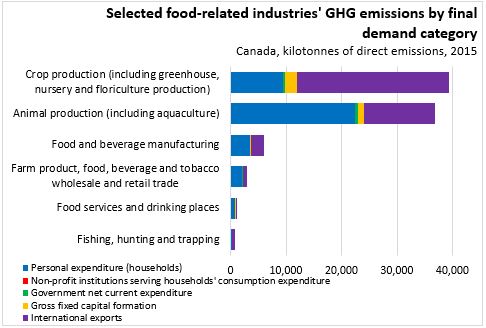The Economics and Statistics Division maintains archives of previous publications for accountability purposes, but makes no updates to keep these documents current with the latest data revisions from Statistics Canada. As a result, information in older documents may not be accurate. Please exercise caution when referring to older documents. For the latest information and historical data, please contact the individual listed to the right.
<--- Return to Archive
For additional information relating to this article, please contact:
October 09, 2019HOUSEHOLD FOOD CONSUMPTION AND CANADIAN GREENHOUSE GAS EMISSIONS, 2015 Statistics Canada released a fact sheet today that provides information on greenhouse gas (GHG) emissions from household food consumption. Emissions associated with restaurant meals or household food items can be attributed to household consumption and are called indirect emissions. These estimates are based on an input-output model that combines physical flow data on GHG emissions by industry with economic data on production and consumption of goods and services.
In 2015, Canadian households and industries emitted 767,289 kilotonnes of GHG emissions (carbon dioxide equivalent). Households were directly responsible for 142,936 kilotonnes of GHG emissions. Direct household emissions are those from motor fuels and lubricants (55.0 per cent of direct household GHGs) and in-home fuel use (45.0 per cent).

Indirect household emissions amounted to 178,915 kilotonnes of GHG emissions in the same year. Together, direct and indirect household emissions accounted for 41.9 per cent of total emissions in 2015. Of the indirect emissions emitted by households, 29.5 per cent were from energy products (electricity, gasoline, natural gas, light fuel oils, natural gas liquids and related products and fuelwood). Another 17.5 per cent resulted from food and beverage products and 7.0 per cent were from food and beverage services. Note that this study does not account for emissions related to purchases of goods and services that are imported into Canada.
When looking at direct GHG emissions by food-related industry, crop and animal production produce the highest emissions. Smaller shares of direct emissions were attributed to food and beverage manufacturing, wholesale and retail trade, and fishing, hunting and trapping. Exported products accounted for 50.1 per cent of emissions associated with these industries in 2015.

Source: Statistics Canada, Household food consumption and Canadian greenhouse gas emissions, 2015
<--- Return to Archive